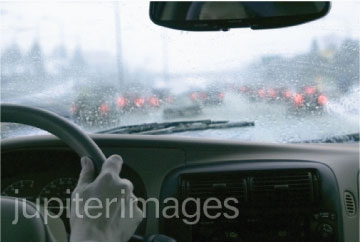By Sarah Walden of UmbrellaBagger.com
Traveling to the office during dangerous weather conditions can be frightening. Safety precautions are necessary for employees and management to remain calm, collected and protected during severe storms. Paying attention to any and all warnings before, during and after a storm secures employees during their commute and office hours. Aside from safety concerns, trekking to work in bad weather is uncomfortable and a lack of preparation can lead to an intolerable day.
Here are four tips to help make the rainy, slushy or snowy commute easier for full-time employees.
Stay Informed and Drive Cautiously
Set up weather alerts on a smart phone or computer the night before a large storm is due. Tune into the morning news while getting ready and take notice of the suggested strategies and tips for the current conditions. When leaving the house, travel with extreme caution and care. If proximity allows, consider carpooling with coworkers – multiple eyes and ears increases awareness of precarious conditions and helps ease stress for drivers.
Dress Appropriately
Invest in a reliable raincoat and sturdy rubber boots. Although clunky and awkward, protective outdoor gear helps keep work clothes dry. Forgoing style during the commute to the office is better than sitting in soggy clothing all day long which can lead to a head cold or wrinkled attire.
Take Advantage of Facility Accommodations
Spend a little more money to park in the indoor garage or covered lot on days when weather is extreme. Opting for street parking is usually the more cost-effective alternative, but defrosting a car after eight to nine hours of snow or ice build up is time consuming. Fallen tree branch damages or sliding accidents cost more time and money than garage parking fees.
Unlike drivers, walkers get stuck with soppy shoes and a wet umbrella after their commute. Office lobbies are often equipped with dry floor mats and a wet umbrella bag dispenser. Both resources prevent slip and fall accidents that are all too common during winter snowstorms and the rainy spring months. Don’t bypass these luxuries; they are in place to keep workforce visitors safe and dry.
Take the Day off or Work from Home
There is no shame in missing work if travel doesn’t feel safe. Use a sick day or paid leave if necessary. Although roads may seem fine in the morning, conditions can change rapidly in the afternoon. Getting home could be a nightmare and pose a greater threat than the initial travel. If necessary, ask to work from home. Most managers allow remote labor, as long as employees have a computer and the basic materials to complete their duties for the day.
Dealing with rain, snow and ice shouldn’t have to interfere with productivity. Instead of letting the weather dictate professional life, take the necessary precautions to aptly coordinate work-related travel.
Thanks, Sarah, for this unique idea for wet umbrella bag dispenser(s). These would work great for work, school, or churches. pb

